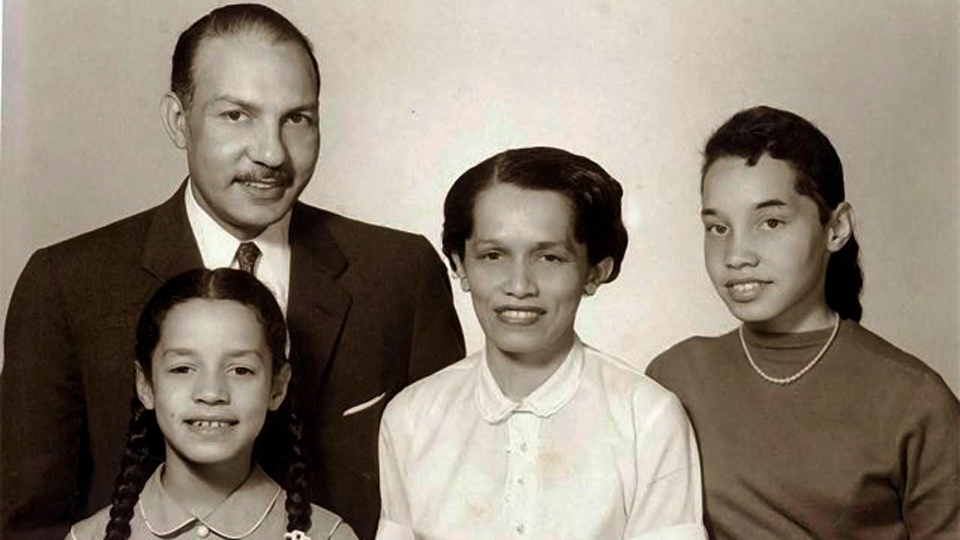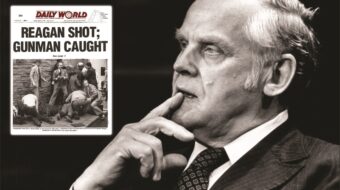
James and Esther Cooper Jackson were mainstays of the struggle for African American equality for decades. Their work spanned the 1930s era National Negro Congress (NNC), the Southern Negro Youth Congress (SNYC), the fight against fascism in World War II, and the emergence of the 1960s Civil Rights, Black Power and peace movements.
Though their career paths eventually diverged, both James E. Jackson, Jr. and Esther Cooper initially found their political compass guided by the Communist Party USA. For during the 1930s it was the CPUSA, more than any other organization that was not African American as such, that championed African American equality and Black Liberation. As a result, thousands of African Americans, including the Jacksons, found a home in the Communist Party and/or party-led organizations like the NNC, the SNYC, or the Sharecroppers Union.
Additionally, it was Communists, like James and Esther Cooper, who helped broaden and expand the antiracist trade unionism of the Congress of Industrial Organizations (CIO), unlike the then almost entirely white, segregated and often racist policies of the American Federation of Labor (AFL). The antiracist contributions by Communists – both Black and white – to the growth of the CIO will likely be studied for years to come.
James and Esther Cooper Jackson: Love and Courage in the Black Freedom Movement, by Sara Rzeszutek Haviland, isn’t just a political history. It is a joint biography of the highest order.
 Haviland not only writes about the couple with an eye toward their many political contributions in the struggle for African American equality and socialism, she also analyzes how their radical commitment to equality in the household, under the trying conditions of World War II, and then McCarthy Era repression, evolved to fit the needs of a collective familial unit.
Haviland not only writes about the couple with an eye toward their many political contributions in the struggle for African American equality and socialism, she also analyzes how their radical commitment to equality in the household, under the trying conditions of World War II, and then McCarthy Era repression, evolved to fit the needs of a collective familial unit.
James and Esther Cooper Jackson weren’t just committed to the class struggle. They were committed to each other over the course of what some historians have rightly referred to as the Long Civil Rights Revolution.
We learn from Haviland that James’ commitment to equality started early. When he was about twelve, “Jack organized the first black troop to be admitted into the Boy Scouts of America in Virginia.” However, the Scout uniform did not garner him the same respect shown white youth, as he was accosted by a white couple wielding James’ very own Boy Scout ax. His crime: “inadvertently” sitting beside them on the bus. Other indignities followed, which eventually led James to recall to Esther Cooper that he had “a ferocious hatred for the haters of my people — later to be enlarged to embrace all the oppressed of the world.”
He joined the CPUSA in 1931, initiating “wonderful years heralding the revolution and toppling the gods of bourgeois respectability in every direction.” James would remain in the party, holding a series of responsible positions in it until the collapse of the Soviet Union in the early 1990s, when he withdrew, though remaining on friendly terms. He died in 2007 just short of his 93rd birthday.
Esther Cooper came to the Party during college, where she was introduced to Marx and the Daily Worker by leftist professors. Additionally, she was acquainted with students who had fought and died defending the Spanish Republic from Franco’s fascism. In her master’s thesis, The Negro Woman Domestic Workers in Relation to Trade Unionism, she suggested that “organizing domestic workers into labor unions would help redefine black women as employees who were embedded in the national economy, both through their own income and by allowing the white women who employed them the leisure time to consume.”
Though her own path to socialism was uniquely feminist and largely intellectual, Esther Cooper nonetheless took-on the challenges of organizing Black workers in Alabama, becoming the administrative mainstay of the SNYC and “the embodiment of the organization’s position on women’s leadership.”
While the SNYC was not immune to sexism, under its largely Communist leadership, it “consistently pressed for the full participation of women in leadership roles and speaking positions,” often encouraging male leaders, like James, to take-on non-traditional gender roles, like housework and child care.
It was this foundation of equality that James and Esther Cooper Jackson embraced in their political and familial life. The two budding revolutionaries married in spring 1941. However, by 1943, the couple, now with an infant daughter, were separated, as James was drafted into the Army.
The Jacksons were not immune to the strains and tensions of war-time separation and post-war political repression, as Esther was for many years left to raise their daughter on her own – first during the war and then during McCarthyism. However, their correspondence often conveyed a deep longing for each other, respect and admiration for each other’s work, a desire for warmth and love, and for the commitment they shared to equality and socialism.
Through it all, Esther “remained uncompromising in her belief that her husband had a democratic right to his Communist political beliefs and that his absence was a severe blow to the black freedom movement.”
After long years of political repression, James entrenched himself in the party and its publications as editor of The Worker, while Esther organized more broadly through Freedomways magazine, a journal of Black liberation she helped to found, and in which she carried her popular front politics of the 1930s into a new era.
As Haviland notes, “The Jacksons’ lives reveal that Cold War anticommunism influenced the direction and methods of the civil rights movement in the 1960s but it did not prevent Communists from contributing to the broad ideological struggle against racial injustice…,” primarily through “editorial work” that “points to a more fluid collaboration among activists across the political spectrum.”
Both James and Esther Cooper Jackson influenced the Civil Rights movement in their own ways; their contributions are acknowledged and appreciated in Haviland’s book. The author captures the life and times of two of the most important African American leaders of the Long Civil Rights Revolution, portraying their endearing love for each other over a marriage that lasted 66 years, and shows how their commitment translated into their public life.
A 2014 interview with Esther Cooper Jackson can be viewed here. Born August 21, 1917, she is living in Brooklyn, in her 100th year.
James and Esther Cooper Jackson: Love and Courage in the Black Freedom Movement
By Sara Rzeszutek Haviland
University of Kentucky Press, 2015
367 pages












Comments